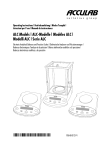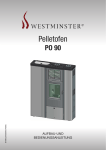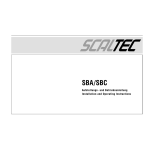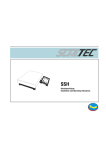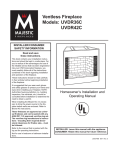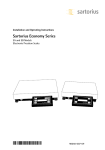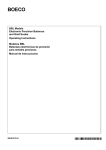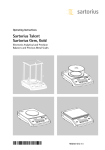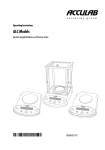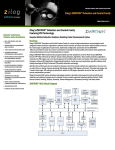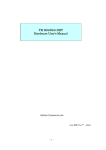Download SPB - Oxford Laboratory Balances
Transcript
SPB Elektronische Präzisionswaagen Betriebsanleitung Electronic Precision Balances Operating Instructions Verwendungszweck Intended Use Die SPB-Serie besteht aus Waagen zum Messen von Wägegütern zwischen 1 mg und 6 kg. The SPB Series from Sartorius offers precision balances/scales with capacities ranging from 1 mg to 6 kg. Die Waagen garantieren zuverlässige Wägeergebnisse durch: – Ausfiltern von ungünstigen Umgebungsbedingungen wie Vibrationen, Luftbewegungen, usw. – Reproduzierbare Wägeergebnisse – Robuste Ausführung These balances meet the highest requirements for the accuracy and reliability of weighing results through the following features: – Efficient filtering-out of unfavorable ambient conditions such as vibrations, drafts, etc. – Stable and reproducible results – Rugged, durable weighing system SPB-Waagen erleichtern und beschleunigen Routineabläufe durch: – Kurze Meßzeiten – Einfache Bedienung Eine weitere Funktion für einfache Anwendungen. Zur Auswahl stehen: – Einheitenwechsel – Netto-Total (Zweiter Taraspeicher) – Zählen – Prozentwägen – Mittelwertbildung 2 SPB balances save work and speed up simple routine applications through: – Ultrafast response times – Easy operation You can also choose from the following extra functions for simple applications: – Toggling between weight units – Net-total formulation (tare memory) – Counting – Weighing in percent – Averaging Inhalt Contents Verwendungszweck 2 Practical Use 2 Inhalt 3 Contents 3 Warn- und Sicherheitshinweise 4 Warning and Safety Information 4 Inbetriebnahme 5 Getting Started 5 Betrieb Grundfunktion Wägen Justieren 11 11 12 Operating the Balance/Scale Basic Weighing Function Calibration/Adjustment 11 11 12 Voreinstellungen (Menü) Parameter einstellen (Menü) Parametereinstellungen (Übersicht) 13 13 14 Configuring the Balance/Scale Setting the Parameters (Menu Codes) Balance/Scale Operating Menu (Overview) 13 13 14 Anwendungsprogramme Zählen Prozentwägen Mittelwertbildung Netto-Total/Zweiter Taraspeicher Einheitenwechsel 15 15 17 19 21 22 Application Programs Counting Weighing in Percent Averaging Net-Total Formulation/Second Tare Memory Toggle between Weight Units 15 15 17 19 21 22 Fehlermeldungen 23 Error Codes 23 Pflege und Wartung 24 Care and Maintenance 24 Entsorgung 25 Instructions for Recycling 25 Übersicht Technische Daten Zubehör (Optionen) C-Kennzeichnung 26 26 30 31 Overview Specifications Accessories (Options) C Marking 26 26 30 31 3 Warn- und Sicherheitshinweise Warning and Safety Information Die Betriebsanleitung aufmerksam durchlesen, bevor das Gerät in Betrieb genommen wird. Dadurch werden Schäden am Gerät vermieden. Die Betriebsanleitung sorgfältig aufbewahren. Read these operating instructions thoroughly before using your balance/scale to prevent damage to the equipment. Keep these instructions in a safe place. Folgende Hinweise sind für einen sicheren und problemlosen Betrieb mit der Waage zu beachten: ! der auf dem Netzgerät aufgedruckte Spannungswert muß mit der lokalen Netzspannung übereinstimmen ! Nur handelsübliche 9 Volt-Block Batterie oder Akku verwenden ! Make sure that the voltage rating printed on the AC adapter is identical to your local line voltage ! Use only a commercially available 9-volt battery or rechargeable battery ! nicht in explosionsgefährdeten Bereichen einsetzen ! Do not use this balance/scale in a hazardous area/location – Waage kann nur durch Ziehen des Netzgerätes spannungslos geschaltet werden – The only way to turn the power off completely is to disconnect the AC adapter – Zubehör und Optionen von SCALTEC verwenden, diese sind optimal auf die Waage abgestimmt – – Netzgerät vor Nässe schützen Connect only SCALTEC accessories and options, as these are optimally designed for use with your balance. – Protect the AC adapter from contact with liquid. Die Waage nicht öffnen. Bei verletzter Sicherungsmarke entfällt der Garantieanspruch. 4 Follow the instructions below to ensure safe and troublefree operation of your balance: Do not open the balance housing. If the seal is broken, this will result in forfeiture of all claims under the manufacturer’s warranty. Inbetriebnahme Getting Started Garantie Warranty Verschenken Sie nicht Ihren erweiterten Garantieanspruch. Schicken Sie uns bitte die vollständig ausgefüllte Garantieanmeldung (siehe Anlage) zurück. Do not miss out on the benefits of our extended warranty. Please complete the warranty registration card and return it to the address listed below (see supplement). Sollte dennoch Ihr Gerät innerhalb der Garantiezeit von 3 Jahren einmal technische Unterstützung benötigen, so verständigen Sie bitte unter Angabe des Gerätetypes, der Serien-Nummer und den Grund Ihrer Beanstandung: In the unlikely event that your balance should require servicing within the 3-year warranty period, please contact your local SCALTEC dealer or: SCALTEC INSTRUMENTS GmbH Rudolf-Diesel-Straße 1 D-37308 Heiligenstadt Telefon: (03606) 6701-0 Fax: (03606) 6701-60 SCALTEC INSTRUMENTS GmbH Rudolf-Diesel-Strasse 1 37308 Heiligenstadt, Germany Phone: (0)3606-6701-0 Fax: (0)3606-6701-60 5 Lager- und Transportbedingungen Storage and Shipping Conditions Das Gerät nicht extremen Temperaturen, Stößen, Vibrationen und Feuchtigkeit aussetzen. Do not expose the balance/scale to shocks, vibrations, moisture or extreme temperatures. Auspacken Unpacking the Balance/Scale ● Das Gerät sofort nach dem Auspacken auf eventuell sichtbare äußere Beschädigungen überprüfen ● After unpacking the balance, check it immediately for any visible damage as a result of rough handling during shipment. $ Im Fall einer Beschädigung: siehe Kapitel »Pflege und Wartung«, Abschnitt »Sicherheitsüberprüfung« Alle Teile der Verpackung für einen eventuell notwendigen Versand aufbewahren, denn nur die Originalverpackung gewährleistet sicheren Transport. Vor dem Versand alle angeschlossenen Kabel trennen, um unnötige Beschädigungen zu vermeiden. 6 $ If you see any sign of damage, proceed as directed in the chapter entitled “Care and Maintenance,” under the section on “Safety Inspection.” Save the box and all parts of the packaging until you have successfully installed your balance. Only the original packaging provides the best protection for shipment. Before packing your balance, unplug all connected cables to prevent damage. Lieferumfang Equipment Supplied Folgende Einzelteile werden mitgeliefert: – Waage – Waagschale – Unterschale – Glasring-Windschutz (nur bei Modell SPB42) – Befestigungsöse für eine Diebstahlsicherung – Steckernetzgerät – Betriebsanleitung The equipment supplied includes the components listed below: – Balance – Weighing pan/load plate – Pan support – Glass draft shield (only with model SPB42) – Anti-theft locking device – AC adapter – Operating instructions Aufstellhinweise Installation Instructions Die Waage ist so konstruiert, daß unter den im Betrieb üblichen Einsatzbedingungen zuverlässige Wägeergebnisse erzielt werden. Exakt und schnell arbeitet die Waage, wenn der richtige Standort gewählt ist: Your balance is designed to provide reliable weighing results under normal ambient conditions. When choosing a location to set up your balance, observe the following so that you will be able to work with added speed and accuracy: – Waage auf eine stabile, gerade Fläche stellen – Set up the balance on a stable, even surface – extreme Wärme durch Aufstellen neben der Heizung oder direkte Sonneneinstrahlung vermeiden – Avoid placing the balance in close proximity to a heater or otherwise exposing the balance to heat or direct sunlight – Waage vor direktem Luftzug schützen (geöffnete Fenster und Türen) – starke Erschütterungen während des Wägens vermeiden – Waage vor aggressiven chemischen Dämpfen schützen – extreme Feuchte vermeiden Waage akklimatisieren: Eine Betauung kann auftreten (Kondensation von Luftfeuchtigkeit am Gerät), wenn ein kaltes Gerät in eine wesentlich wärmere Umgebung gebracht wird. Das vom Netz getrennte Gerät ca. 2 Stunden bei Raumtemperatur akklimatisieren. – Protect the balance from drafts that come from open windows or doors – Avoid exposing the balance to extreme vibrations during weighing – Protect the balance from aggressive chemical vapors – Do not expose the balance to extreme moisture over long periods Conditioning the Balance: Moisture in the air can condense on the surfaces of a cold balance whenever it is brought into a substantially warmer place. If you transfer the balance to a warmer area, make sure to condition it for about 2 hours at room temperature, leaving it unplugged from AC power. 7 Waage aufstellen Setting up the Balance Waagen mit Glasringwindschutz Balances with a Glass Draft Shield: § Teile nacheinander aufsetzen: – Deckel mit dem Rand nach oben auf die Waage setzen und drehen, bis er fest sitzt – Unterschale – Waagschale – Glasaufsatz – Deckel mit dem Rand nach unten § Place the components listed below on the balance in the order given: – Shield ring – place it on the balance so that the edge for fitting the glass draft shield faces upwards and turn it until it is firmly in place. – Pan support – Glass draft shield – Weighing pan – Draft shield cover Waagen mit Waagschale Ø 115 mm Balances with a Round Weighing Pan § Place the components listed below on the balance in the order given: – Pan support – Weighing pan/load plate § Teile nacheinander aufsetzen: – Unterschale – Waagschale Waagen mit Waagschale Ø 150 mm § Waagschale aufsetzen Balances with a Rectangular Weighing Pan § Place the weighing pan/load plate on the balance Connecting the Balance to AC Power/Safety Precautions Netzanschluß/Schutzmaßnahmen Verwenden Sie nur – Originalnetzgerät für Europa: 6971948 § Winkelstecker an der Waage einsetzen § Netzgerät der Schutzklasse 2 darf ohne weitere Maßnahmen an jede Steckdose angeschlossen werden 8 Die Ausgangsspannung ist durch einen Pol mit dem Waagengehäuse verbunden. Das Waagengehäuse darf zu Funktionszwecken geerdet werden. Use only original Sartorius AC adapters: – for Europe: 6971948 – for the RSA: 6971949 – for the US: 6971947 – for Australia: 6971950 § Insert the right-angle plug into the jack § The AC adapter rated to Class 2 can be plugged into any wall outlet without requiring any additional safety precautions The ground is connected to the balance housing, which can be additionally grounded for operation. Batterie/Akku einsetzen (nicht bei Modellen SPB42, SPB52) Using a (Rechargeable) Battery (not for models SPB42, SPB52) $ Batterie oder Akku gehören nicht zum Lieferumfang der Waage $ Battery is not included with the equipment supplied ! Nur handelsübliche 9 Volt-Block Batterie oder Akku verwenden ! Akku nur mit externem Ladegerät laden ! Use only a commercially available (rechargeable) 9volt battery ! When using a rechargeable battery, always use an external recharging device to recharge the battery § Waage auf die Seite drehen § Batteriefach öffnen: Batteriefachabdeckung anheben § Lay the balance on its side § Open the battery compartment: Lift the compartment cover § 9 Volt-Block Batterie oder Akku in die Batteriehalterung einsetzen $ Polarität beachten § Insert the 9-volt (rechargeable) battery in the compartment $ Make sure to connect the positive and negative poles correctly ! Verbrauchte Batterien oder Akkus sind Sondermüll (kein Hausmüll): Akkus gemäß Abfallwirtschaftsgesetz als Sondermüll speziell entsorgen § Batteriefach schließen: Batteriefachabdeckung herunterdrücken und einrasten lassen ! All used batteries are classified as waste that requires special handling (not “household” waste). Dispose of rechargeable batteries in accordance with the applicable special waste disposal regulations. § Close the battery compartment: Press down on the cover until it clicks into place 9 10 Waage nivellieren (nur bei Modellen SBP42, SBP52) Leveling the Balance (only for models SBP42, SBP52) Die Waage nach jedem Stellplatzwechsel neu nivellieren. Level the balance any time you set it up in a new location. Das Nivellieren erfolgt nur mit den beiden vorderen Stellfüßen. Use only the 2 front feet of the balance for leveling. § Beide hintere Stellfüße eindrehen (nur bei SBP52) § Turn the 2 rear feet until they are in position (only on models SBP52) § Vordere Fußschrauben gemäß Abbildung so drehen, bis die Luftblase der Libelle in der Kreismitte steht § Turn the 2 front feet as shown here in the illustration until the air bubble is centered in the level indicator > In der Regel sind mehrere Nivellierschritte nötig > In most cases this will require several adjustment steps Betrieb Operating the Balance Grundfunktion Wägen Basic Weighing Function Merkmale – Waage tarieren Das Tarieren kann innerhalb des gesamten Wägebereichs der Waage erfolgen. Available Features – Taring the balance You can tare the balance within the entire weighing range. Vorbereitung § Waage einschalten: Taste [ON/OFF] drücken § Ggf. Voreinstellungen ändern: siehe Kapitel »Voreinstellungen« § Ggf. Werksvoreinstellungen laden: siehe Kapitel »Voreinstellungen«, Parameter 9. – 1 $ Ggf. Waage tarieren: Taste t drücken Preparation § Turn on the balance: Press [ON/OFF] § To change configurations: See the chapter entitled “Configuring the Balance” § To load factory-set configurations: See “Configuring the Balance,” parameter 9 – 1 $ To tare the balance: Press t Weitere Funktion: § Waage ausschalten: Taste [ON/OFF] drücken Additional Functions § To turn off the balance: Press [ON/OFF] Beispiel Wägewert ermitteln Voreinstellungen: wie Werksvoreinstellungen Example Basic weighing Menu code settings: Factory-set codes Schritt Taste drücken 1. Waage einschalten [ON/OFF] Anzeige Selbsttest wird durchgeführt 4. Wägegut in Behälter legen (hier z.B. 150,2 g) Key (or instruction) Display 1. Turn on the balance [ON/OFF] Self-test is performed 2. Behälter für Wägegut auflegen (hier z.B. 52 g) 3. Waage tarieren Step t + 52.0 g + 0.0 g + 150.2 g 2. Place container on balance scale (here: 52 g) 3. Tare the balance 4. Place sample in container on balance (here: 150.2 g) t + 52.0 g + 0.0 g + 150.2 g 11 Justieren Die Waage nach der Installation am Aufstellort justieren. Calibration/Adjustment* Always calibrate/adjust the balance after setting it up in a new location. Merkmale Der Justiervorgang kann nur gestartet werden, wenn – die Waage unbelastet ist – die Waage tariert ist – das interne Wägesignal stabil ist Sind diese Voraussetzungen nicht erfüllt, erscheint eine Fehlermeldung. Das zur Justierung erforderliche Gewicht wird in der Anzeige angezeigt (Gewichte siehe Abschnitt »Zubehör«). Available Features Calibration/adjustment can only be performed when – there is no load on the balance, – the balance is tared, – the internal signal is stable. If these conditions are not met, an error message is displayed. The weight required for calibration/adjustment is displayed (see “Accessories” for calibration weights). Das Justieren kann bei mit unterschiedlichen Gewichtseinheiten erfolgen: g, kg, lb (Code1. 4. x) Werksvoreinstellung: Gramm (Code 1. 4. 1) Calibration/adjustment can be performed with any of three weight units: g, kg, or lb (menu code 1. 4. x) Factory setting: Grams (menu code 1. 4. 1) Beispiel Waage justieren / Voreinstellungen: wie Werksvoreinstellungen Schritt Taste drücken Anzeige Example Calibrate the balance Step Key (or instruction) Display 1. Waage ggf. einschalten [ON/OFF] 1. Turn on the balance [ON/OFF] 2. Waage tarieren t 2. Tare the balance t + 0.0 g 3. Justiervorgang starten [CAL/CF] Justiergewicht wird ohne Einheit angezeigt (hier z.B. 1000 g) + 1000.0 g 4. Angezeigtes Justiergewicht auflegen nach dem Justieren erscheint das Justiergewicht mit Einheit + 150.2 g + 1000.0 g 5. Justiergewicht abnehmen 0.0 g + 0.0 g 3. Begin calibration [CAL/CF] Calibration weight is displayed without weight unit (here: 1000 g) + 1000.0 g 4. Place the indicated calibration weight on the balance After calibration, the calibration weight is displayed with wt. unit + 150.2 g + 1000.0 g 5. Remove the calibration weight * 12 0.0 g “Calibration” technically means to determine the difference between the balance readout and the actual weight on the pan to determine the accuracy. Adjustment means to bring a balance into the state of accuracy required for its use. Therefore, “calibration,” as used in this manual, actually means “adjustment.” Voreinstellungen Configuring the Balance Parameter einstellen (Menü) Konfiguration der Waage, d.h. Anpassung an die Anforderungen der Benutzer durch Auswahl von vorgegebenen Parametern aus einem Menü. Beispiel: Anpassung an den Aufstellort »Sehr unruhige Umgebung« (Code 1, 1. 4) wählen Schritt Taste drücken Anzeige Setting the Parameters (Menu Codes) You can configure your SPB balance to meet individual requirements by selecting from the parameters available in the menu. Example: Adapt the balance to unstable ambient conditions: Menu code 1, 1. 4 Step Key (or instruction) Display 1. Waage ausschalten 2. Waage einschalten und während der Anzeige aller Segmente $ Innerhalb einer Menüebene bewegen; nach dem letzten Menüpunkt erscheint wieder der erste Menüpunkt 3. Menüebene 2 anwählen 4. Menüebene 3 anwählen 5. Menüebene 3: Menüpunkt wählen 6. Einstellungsänderung bestätigen; »o« zeigt den eingestellten Menüpunkt an $ Zurück zur übergeordneten Menüebene (von der 3. Menüebene) $ Ggf. weitere Menüpunkte einstellen 7. Parametereinstellung speichern und Menü verlassen oder $ Parametereinstellung ohne Abspeichern verlassen 1. Turn off the balance 2. Turn the balance back on;while all segments are displayed $ To navigate within a menu level; the last menu option is followed by the first option 3. Select the 2nd menu level 4. Select the 3rd menu level 5. In Menu Level 3: Select the desired option 6. Confirm new setting; the “o” indicates the currently set option $ Select the next menu level (here: move from the 3rd to the 1st level) $ Set other menu codes, if desired 7. Store parameter settings and exit operating menu or $ Exit operating menu without storing changes > Restart the application [ON/OFF] [ON/OFF] kurz t mehrmals t [PRINT] [PRINT] 1. 2. ... 9. 1. 1. 1. 1. 1. 2 ο mehrmals t 1. 1. 4 2 Sekunden lang [PRINT] 1. 1. 4 ο [PRINT] [PRINT], t 2 Sekunden lang t [ON/OFF] 1. [ON/OFF] [ON/OFF] t briefly t repeatedly [PRINT] [PRINT] 1. 2. ... 1. 1. 1. 1. 1. 2 ο repeatedly t 1. 1. 4 [PRINT] for 2 sec. 1. 1. 4 ο [PRINT] [PRINT], t t for 2 sec. 1. [ON/OFF] 0.0 g 0.0 g 13 Parametereinstellungen (Übersicht) Balance Operating Menu (Overview) o Werksvoreinstellung √ Einstellung Benutzer o Factory setting √ User setting Menü ne 1 üebe Men ne 2 üebe Men ng ne 3 stellu punkt üebe erksein ü W Men Men 1 Wägen 1.1. Filteranpassung 1.1.1 1.1.2 1.1.3 1.1.4 Sehr ruhige Umgebung o Ruhige Umgebung Unruhige Umgebung Sehr unruhige Umgebung 1.3. Stillstandsbereich 1.3.1 1.3.2 1.3.3 1.3.4 1.3.5 1.4. Gewichtseinheit für Justiergewicht ** 2. Anwendungsprogramme el 1 u lev Men el 2 u lev Men g el 3 el 4 ettin u lev actory s u lev Men Men F 1. Balance functions 1.1. Adapt filter 1.1.1 1.1.2 1.1.3 1.1.4 Minimum vibration o Normal vibration Strong vibration Extreme vibration 1/4 Ziffernschritt 1/2 Ziffernschritt 1 Ziffernschritt o 2 Ziffernschritte 4 Ziffernschritte 1.3. Stability range 1.3.1 1.3.2 1.3.3 1.3.4 1.3.5 1/4 digit 1/2 digit 1 digit o 2 digits 4 digits 1.4.1 1.4.2 1.4.3 o Gramm Kilogramm Pound 1.4. Weight unit for calibration weight 1.4.1 1.4.2 1.4.3 o Grams Kilograms Pounds 1.6. Autozero 1.6.1 1.6.2 o Eingeschaltet Ausgeschaltet 1.6. Auto zero 1.6.1 1.6.2 o On Off 1.7. Gewichtseinheit 1 siehe Abschnitt »Einheitenwechsel« 1.7. Weight unit 1 See “Toggle between Weight Units” 2.1. Programmwahl siehe jeweiliges Anwendungsprogramm 2. Application programs 2.1. Program selection see the desired application program description 3. Application parameters 3.1. Weight unit 2 see “Toggle between Weight Units” 3.3. Reference qty or % see the desired application program description 3. Anwendungsparameter 3.1. Gewichtseinheit 2 siehe Abschnitt »Einheitenwechsel« 3.3. Referenz-Stück/-% siehe jeweiliges Anwendungsprogramm 5. bis 7. nur relevant mit eingebauter Datenschnittstelle; siehe zugehörige Anleitung 5. through 7. applies only if an interface is installed; see the corresponding instructions 8. Zusatzfunktionen 8.1. Menü 8. Extra functions 8.1. Menu 8.1.1 8.1.2 8.2. External switch function applies only if an interface is installed; see the corresponding instructions 8.3. Power-on mode 8.3.1 8.1.1 8.1.2 9. Menü-Reset 14 Menu o Parametereinstellung veränderbar Parameter nur lesen 8.2. Funktion des ext. Tasters nur relevant mit eingebauter Schnittstelle 8.3. Einschalten der Waage 8.3.1 9.– Werkseinstellung Aus/ein (Batteriebetrieb: Autom. aus nach 3 Min.) 8.3.2 o Stand-by/ein 9.– 1 9.– 2 wiederherstellen o nicht wiederherstellen 9. Reset menu 9.– Factory settings o Parameter settings alterable Parameter settings read only Off/on (battery shuts off automatically after 3 min) 8.3.2 o Stand-by/on 9.– 1 9.– 2 Reset o Do not reset Anwendungsprogramme Application Programs Zählen (Code 2, 1. 4) Counting (Code 2, 1. 4) Zweck Mit diesem Anwendungsprogramm kann die Anzahl von Teilen ermittelt werden, die ein annähernd gleiches Stückgewicht haben. Purpose The counting program allows you to count the number of parts that have approximately the same weight. Merkmale – Übernahme des aktuellen Wägewertes als eingestellten Stückzahl für die Initalisierung beim Start des Programms »Zählen« – Ändern der Referenzstückzahl im Menü möglich: siehe Kapitel »Voreinstellungen« – Automatische Ausgabe des Stückgewichtes über die optionale Datenschnittstelle nach Abschluß der Initialisierung, wenn Ausdruck mit Kennzeichnung im Menü eingestellt ist – Umschalten zwischen Stückzahlanzeige und Gewichtswertanzeige mit Taste [FUNCTION] Available Features – Store the current weight value to have it loaded as the preset reference sample quantity next time you initialize the Counting application – The reference sample quantity can be changed in the operating menu: See “Configuring the Balance” – The average piece weight is automatically output via the optional data interface port after initialization, if the menu code for “Printout with data ID codes” is set – Press [FUNCTION] to toggle the display between piece count and weight Werksvoreinstellung der Parameter Referenzstückzahl: 10 (Code 3. 3. 2) Factory Settings Reference sample quantity: 10 (menu code 3. 3. 2) Vorbereitung § Anwendungsprogramm »Zählen« im Menü einstellen: siehe »Voreinstellungen« Code 2. 1. 4 Zählen Preparation § Configure the Counting application in the operating menu: See “Configuring the Balance” Menu code 2. 1. 4 Counting § Referenzstückzahl: Code 3. 3. 1 5 Stück Code 3. 3. 2 10 Stück Code 3. 3. 3 20 Stück Code 3. 3. 4 50 Stück Code 3. 3. 5 100 Stück § Reference sample quantity: Menu code 3. 3. 1 5 pcs Menu code 3. 3. 2 10 pcs Menu code 3. 3. 3 20 pcs Menu code 3. 3. 4 50 pcs Menu code 3. 3. 5 100 pcs siehe auch Kapitel »Voreinstellungen« See also “Configuring the Balance” 15 Beispiel Ermittlung einer unbekannten Stückzahl: Vorgegebene Referenzstückzahl wiegen Example Determine an unknown piece count; weigh the preset reference sample quantity Voreinstellungen (Abweichungen von der Werksvoreinstellung): Menü: Anwendungsprogramm Zählen (Code 2. 1. 4), Referenzstückzahl 20 (Code 3. 3. 3) Settings (changes in the factory settings required for this example): Menu: Application program: Counting (2. 1. 4) Reference sample quantity: 20 pcs (3. 3. 3) Schritt Step Taste drücken 1. Waage ggf. einschalten [ON/OFF] 2. Waage tarieren t Anzeige 0.0 g Key (or instruction) Display 1. Turn on the balance [ON/OFF] 2. Tare the balance t 0.0 g 3. Information: Referenzstückzahl [FUNCTION] lang anzeigen (hier z.B. 20 Stück) ref 20 (kurzzeitig) 3. Display the reference sample [FUNCTION] >2 sec. ref 20 (briefly) quantity (here: 20 pcs) 4. Referenzstückzahl (20 Stück) auflegen (hier z.B. 66 g) + + 5. Anwendung starten; wenn [FUNCTION] Ausdruck mit Kennzeichnung gewählt ist, wird ausgedruckt + 4. Place the reference sample quantity (20 pcs) on the) balance (here: 66 g) 5. Start the application; if the print [FUNCTION] format is set to include data ID codes, the following is printed + 6. Weigh uncounted parts (here: 174 pcs) + 6. Unbekannte Stückzahl auflegen (hier z.B. 174 Stück) 66.0 g 20 pcs wRef + 3.300 g + 174 pcs 7. Gewicht anzeigen [FUNCTION] + 574.2 g 8. Stückzahl anzeigen [FUNCTION] + 9. Waage entlasten 10. Referenzwert löschen 11. Ggf. weiter bei 6. 16 174 pcs 0 pcs [CAL/CF] lang 66.0 g 20 pcs wRef + 3.300 g 174 pcs 7. Display weight [FUNCTION] + 574.2 g 8. Display quantity [FUNCTION] + 9. Unload the balance 10. Delete the reference value 11. Repeat the procedure starting from Step 6, if desired. 174 pcs 0 pcs [CAL/CF] >2 sec. Prozentwägen (Code 2, 1. 5) Weighing in Percent (Code 2, 1. 5) Zweck Mit diesem Anwendungsprogramm kann der prozentuale Anteil eines Wägegutes bezogen auf ein Referenzgewicht ermittelt werden. Purpose This application program allows you to obtain weight readouts in percent which are in proportion to a reference weight. Merkmale – Übernahme des aktuellen Wägewertes als eingestellte Prozentzahl für die Initalisierung beim Start des Programms »Prozentwägen« – Ändern der Referenzprozentzahl im Menü möglich: siehe Kapitel »Voreinstellungen« – Automatische Ausgabe des Referenzgewichtes über die optionale Datenschnittstelle nach Abschluß der Initialisierung, wenn Ausdruck mit Kennzeichnung im Menü eingestellt ist – Umschalten zwischen Prozentzahlanzeige und Gewichtswertanzeige mit Taste [FUNCTION] Available Features – Store the current weight value to have it loaded as the preset reference percentage next time you initialize the Weighing in Percent application – The reference percentage can be changed in the operating menu: See “Configuring the Balance” – The reference percentage is automatically output via the optional data interface port after initialization, if the menu code for “Printout with data ID codes” is set – Press [FUNCTION] to toggle the display between percentage and weight Werksvoreinstellungen der Parameter Referenzprozentzahl: 10 (Code 3. 3. 2) Factory Settings Reference percentage: 10 (menu code 3. 3. 2) Vorbereitung § Anwendungsprogramm »Prozentwägen« im Menü einstellen: siehe »Voreinstellungen« Code 2. 1. 5 Prozentwägen Preparation § Configure the Weighing in percent application in the operating menu: See “Configuring the Balance” Menu code 2. 1. 5 Weighing in percent § Referenzprozentzahl: Code 3. 3. 1 5% Code 3. 3. 2 10 % Code 3. 3. 3 20 % Code 3. 3. 4 50 % Code 3. 3. 5 100 % § Reference percentage: Menu code 3. 3. 1 5% Menu code 3. 3. 2 10 % Menu code 3. 3. 3 20 % Menu code 3. 3. 4 50 % Menu code 3. 3. 5 100 % siehe auch Kapitel »Voreinstellungen« See also “Configuring the Balance” 17 Beispiel Prozentwert messen mit: Referenzgewicht übernehmen durch aufgelegtes Gewicht Voreinstellungen (Abweichungen von der Werksvoreinstellung): Menü: Anwendungsprogramm Prozentwägen (Code 2. 1. 5), Menü: Referenzprozentzahl 100% (Code 3. 3. 5) Schritt Taste drücken Anzeige Example Determine an unknown percentage; store the weight on the balance as a reference percentage Settings (changes in the factory settings required for this example): Menu: Application program: Weighing in percent (2. 1. 5) Menu: Reference percentage 100 % (3. 3. 5) Step 1. Waage ggf. einschalten [ON/OFF] 2. Waage tarieren t 3. Information: Referenzstückzahl anzeigen [FUNCTION] lang 0.0 g re f100 4. Referenzgewicht für 100% auflegen (hier z.B. 222,5 g) + 222.5 g 5. Anwendung starten; wenn [FUNCTION] Ausdruck mit Kennzeichnung gewählt ist, wird ausgedruckt +100.00 pcs 6. Unbekanntes Gewicht auflegen (hier z.B. 322,5 g) wxx% + 222.500 g +144.94 % 7. Gewicht anzeigen [FUNCTION] + 322.5 g 8. Prozentzahl anzeigen [FUNCTION] +144.94 pcs 9. Waage entlasten 10. Referenzprozentzahl löschen [CAL/CF] lang 11. Ggf. weiter bei 6. 18 0.00 % Key (or instruction) Display 1. Turn on the balance [ON/OFF] 2. Tare the balance t 3. Display the reference percentage [FUNCTION] >2 sec. re f100 0.0 g 4. Place the reference weight for 100% on the balance (here: 222.5 g) + 222.5 g 5. Start application; if the print [FUNCTION] format is set to include data ID codes, the following is printed +100.00 pcs 6. Place an unknown weight on the balance (here: 322.5 g) wxx% + 222.500 g +144.94 % 7. Display weight [FUNCTION] + 322.5 g 8. Display percentage [FUNCTION] +144.94 pcs 9. Unload the balance 10. Delete the reference percentage [CAL/CF] >2 sec. 11. Repeat the procedure starting from Step 6, if desired. 0.00 % Mittelwertbildung (Code 2, 1. 12) Averaging (Code 2, 1. 12) Zweck Mit diesem Anwendungsprogramm ist die Messung von Wägegütern in extrem unruhiger Umgebung möglich. Dafür wird über mehrere Meßzyklen ein Mittelwert gebildet. Purpose Use this program to determine weights under unstable ambient conditions. In this program, the balance calculates the weight as the average value from a defined number of individual weighing operations. These weighing operations are also known as “subweighing operations” or “subweighs.” Merkmale – Meßergebnis (arithmetischer Mittelwert) erscheint als feste Anzeige in der vorgewählten Gewichtseinheit mit Kennzeichnung »Dreieck« – Anzahl der Messungen kann im Menü eingestellt werden: siehe Kapitel »Voreinstellungen« – Anzeige der Anzahl Messungen für die Mittelwertbildung (Taste [FUNCTION] lange drücken) – Umschalten zwischen Meßergebnisanzeige und normaler Gewichtsanzeige mit Taste [FUNCTION] Werksvoreinstellungen der Parameter Anzahl Messungen für Mittelwertbildung: 10 (3. 3. 2) Vorbereitung § Anwendungsprogramm »Mittelwertbildung« im Menü einstellen: siehe Kapitel »Voreinstellungen« Code 2. 1.12 Mittelwertbildung – Anzahl Messungen für Mittelwertbildung: 3. 3. 1 5 Messungen 3. 3. 2 10 Messungen 3. 3. 3 20 Messungen 3. 3. 4 50 Messungen 3. 3. 5 100 Messungen siehe auch Kapitel »Voreinstellungen« Available Features – The measured result displayed is the arithmetic mean shown in the selected weight unit; a triangle under the plus or minus sign indicates that this is a calculated value – You can set the number of subweighing operations performed in the operating menu: See “Configuring the Balance” – Press [FUNCTION] for at least 2 sec. to display the pre-set number of subweighing operations – Press [FUNCTION] to toggle the display between the calculated result and the weight Factory Settings Number of subweighs for averaging: 10 (3. 3. 2) Preparation § Configure the Averaging application in the operating menu: See “Configuring the Balance” Menu code 2. 1.12 Averaging – Number of subweighs for averaging: 3. 3. 1 5 subweighs 3. 3. 2 10 subweighs 3. 3. 3 20 subweighs 3. 3. 4 50 subweighs 3. 3. 5 100 subweighs See also “Configuring the Balance” 19 Beispiel Wägewert ermitteln in extrem unruhiger Umgebung mit 10 Messungen für eine Mittelwertbildung. Example Determine the weight of a sample in extremely unstable ambient conditions by calculating the average of 10 subweighing operations. Voreinstellungen (Abweichungen von der Werksvoreinstellung): Menü: Anwendungsprogramm Mittelwertbildung (Code 2. 1.12) Settings (changes in the factory settings required for this example): Menu: Application program: Averaging (menu code 2. 1.12) Schritt Taste drücken Step Key (or instruction) Display 1. Waage ggf. einschalten [ON/OFF] 1. Turn on the balance [ON/OFF] 2. Waage tarieren t 2. Tare the balance t 3. Anzahl der Untermessungen anzeigen (hier z.B. 10 Messungen) [FUNCTION] lang 3. Display the number of subweighs (here: 10) [FUNCTION] >2 sec. re f 10 (briefly) 4. Wägegut auflegen (angezeigter Gewichtswert schwankt, hier z.B. um 275 g) 5. Messung starten [FUNCTION] Nach 10 Messungen Wenn Ausdruck mit Kennzeichnung gewählt ist, wird ausgedruckt 6. Waage entlasten 7. Meßergebnis löschen [CAL/CF] lang 8. Ggf. weiter bei 4. 20 Anzeige 0.0 g re f 10 (kurzzeitig) + 8888 + 8888 10 9 8 … 1 + 275.5 g G RES + 275.5 g + 275.5 g G 4. Place sample on the balance (weight readout fluctuates; here: around 275 g) 5. Start measurement 0.0 g + 8888 [FUNCTION] If the print format is set to include data ID codes, the following is printed 6. Unload the balance 7. Delete the result [CAL/CF] >2 sec. 8. Repeat the procedure starting from Step 4, if desired. + 8888 10 9 8 … 1 + 275.5 g G RES + 275.5 g + 275.5 g G Netto-Total/ Zweiter Taraspeicher (Code 2.1.3) Net-Total Formulation/ Second Tare Memory (Code 2.1.3) Mit diesem Anwendungsprogramm können Komponenten für ein Gemisch eingewogen werden. With this application program you can weigh in components for formulation of a mixture. Vorbereitung Anwendungsprogramm »Netto-Total/Zweiter Taraspeicher« im Menü einstellen: siehe Kapitel »Voreinstellungen« Code 2.1. 3 Preparation Configure the Net-total formulation/Second tare memory application in the operating menu: See “Configuring the Balance” Menu code 2.1. 3 Beispiel Schritt Taste drücken Example Step Key (or instruction) Display 1. Waage ggf. einschalten [ON/OFF] 1. Turn on the balance [ON/OFF] 2, Leeren Behälter zum Einfüllen der Komponenten auf die Waage stellen 3. Waage tarieren Anzeige + 65.0 g 2, Place an empty container on the balance 3. Tare the balance t 4. Erste Komponente einfüllen 5. Komponente übernehmen [FUNCTION] Wenn Ausdruck mit Kennzeichnung gewählt ist, wird ausgedruckt N1 6. Nächste Komponente einfüllen + [FUNCTION] 8. Ggf. weitere Komponenten einfüllen Schritt 5 und 6 entsprechend oft wiederholen 9. Gesamtgewicht anzeigen und ggf. zum gewünschten Endwert auffüllen [CAL/CF] lang 0.0 gNET + 120.5 g 70,5 g 0.0 gNET + 191,0 g 65.0 g t 4. Add the first component + 120,5 g 7. Komponente übernehmen + + 120,5 g 5. Store the first component weight [FUNCTION] If the print format is set to include data ID codes, the following is printed N1 6. Add the next component + 7. Store the 2nd component weight [FUNCTION] 8. Add further components, if desired As described for Steps 5 and 6 9. Display total weight [CAL/CF] >2 sec. and fill to desired final weight 0.0 gNET + 120.5 g 70,5 g 0.0 gNET + 191,0 g 21 Einheitenwechsel Toggle between Weight Units Mit diesem Anwendungsprogramm kann ein Wägewert in zwei unterschiedlichen Einheiten angezeigt werden. With this application program you can toggle the display of a weight value back and forth between two weight units. Anwendungsprogramm »Einheitenwechsel« im Menü einstellen: siehe Kapitel »Voreinstellungen« Code 2.1. 2 Einheitenwechsel Configure the “Toggle weight units” application in the operating menu: See “Configuring the Balance” menu code 2.1. 2 Toggle weight units Menüpunkt 1. 7. 2* 3. 1. 2* 1. 7. 3 3. 1. 3 1. 7. 4 3. 1. 4 1. 7. 5 3. 1. 5 1. 7. 6 3. 1. 6 1. 7. 7 3. 1. 7 1. 7. 8 3. 1. 8 1. 7. 9 3. 1. 9 1. 7. 10 3. 1. 10 1. 7. 11 3. 1. 11 1. 7. 12 3. 1. 12 1. 7. 13 3. 1. 13 1. 7. 14 3. 1. 14 1. 7. 15 3. 1. 15 1. 7. 16 3. 1. 16 1. 7. 17 3. 1. 17 1. 7. 18 3. 1. 18 1. 7. 19 3. 1. 19 1. 7. 20 3. 1. 20 * = Werksvoreinstellung Einheit Gramm Kilogramm Carat Pound Ounce Troy ounce Tael Hongkong Tael Singapur Tael Taiwan Grain Pennyweight Milligramm Parts per Pound Tael China Momme Karat Tola Baht Mesghal Umrechnung 1,00000000000 0,00100000000 5,00000000000 0,00220462260 0,03527396200 0,03215074700 0,02671725000 0,02645544638 0,02666666000 15,43235835000 0,64301493100 1000,00000000000 1,12876677120 0,02645547175 0,26670000000 5,00000000000 0,08573333810 0,06578947437 0,21700000000 Funktion § Zwischen Gewichtseinheit 1 und Gewichtseinheit 2 wechseln: Taste [FUNCTION] drücken 22 Druck g kg ct lb oz ozt tlh tls tlt GN dwt mg /lb tlc mom K tol bat MS Menu code Unit Conversion factor 1. 7. 2* 3. 1. 2* 1. 7. 3 3. 1. 3 1. 7. 4 3. 1. 4 1. 7. 5 3. 1. 5 1. 7. 6 3. 1. 6 1. 7. 7 3. 1. 7 1. 7. 8 3. 1. 8 1. 7. 9 3. 1. 9 1. 7. 10 3. 1. 10 1. 7. 11 3. 1. 11 1. 7. 12 3. 1. 12 1. 7. 13 3. 1. 13 1. 7. 14 3. 1. 14 1. 7. 15 3. 1. 15 1. 7. 16 3. 1. 16 1. 7. 17 3. 1. 17 1. 7. 18 3. 1. 18 1. 7. 19 3. 1. 19 1. 7. 20 3. 1. 20 * = Factory setting Grams Kilograms Carast Pounds Ounces Troy ounces Hong Kong taels Singapur taels Taiwanese taels Grains Pennyweights Milligrams Parts per pound Chinese taels Mommes Austrian carats Tola Baht Mesghal 1.00000000000 0.00100000000 5.00000000000 0.00220462260 0.03527396200 0.03215074700 0.02671725000 0.02645544638 0.02666666000 15.43235835000 0.64301493100 1000.00000000000 1.12876677120 0.02645547175 0.26670000000 5.00000000000 0.08573333810 0.06578947437 0.21700000000 Funktion § To toggle the display between the 1st and 2nd weight units: Press the [FUNCTION] key Abbr. on printout g kg ct lb oz ozt tlh tls tlt GN dwt mg /lb tlc mom K tol bat MS Fehlermeldungen Error Codes Fehlermeldungen werden in der Hauptanzeige für ca. 2 Sekunden dargestellt. Danach kehrt das Programm automatisch in den Wägezustand zurück. Error codes are shown in the main display for approx. 2 seconds, after which the program automatically returns to the weighing mode. Anzeige keine Anzeigesegmente erscheinen Ursache Keine Betriebsspannung Netzgerät nicht eingesteckt Batterie oder Akku ist leer Display No segments appear on the display h l Wägebereich überschritten Waagschale nicht aufgelegt Berührung zwischen Waagschale und Umgebung Anzeigeüberlauf: Auszugebender Wert in der Anzeige nicht darstellbar Justierbedingung wurde nicht eingehalten, z.B.: – Nullstellen – Waagschale belastet Taste t gesperrt bei belegtem zweiten Taraspeicher (Netto-Total) Tarafunktionen sind gegeneinander verriegelt Wert für zweiten Taraspeicher nicht erlaubt Gewicht zu gering oder kein Wägegut auf der Waagschale bei Anwendungsprogrammen Datenschnittstelle für Druckausgabe gesperrt Waage ohne aufgelegte Waagschale eingeschaltet Waage nicht justiert Vor dem Wägen nicht tariert e 01 e 02 e 10 e 11 e 22 e 30 Max. Wägebereich kleiner als im Abschnitt »Technische Daten« angegeben Offensichtlich falsches Wägeergebnis Abhilfe Stromversorgung überprüfen Netzgerät an die Stromversorgung anschließen Batterie wechseln Akku aufladen mit externem Ladegerät Waagschale entlasten Waagschale korrekt auflegen Waagschale darf umgebende Teile nicht berühren Wägegut verringern Waage entlasten Tarieren mit Taste t Erst nach Nullanzeige justieren Erst nach Löschen des Taraspeichers über [CAL/CF] lang ist die Tariertaste wieder ausführbar Taste t drücken Gewicht erhöhen SCALTEC-Kundendienst ansprechen Waagschale auflegen Aus- und wieder Einschalten mit Taste e Justieren Tarieren Falls andere Fehlermeldungen auftreten, SCALTEC-Kundendienst anrufen! Cause No AC power is available The AC adapter is not plugged in Battery is dead Solution Check the AC power supply Plug in the AC adapter Replace the battery Recharge the battery using an external recharging device h The load exceeds the balance capacity Unload the balance l The load plate is not in place Place the load plate on the balance Something is touching Move the object that is the load plate touching the load place e 01 Display capacity exceeded: Decrease the weight on the scale Value to be output cannot be shown on the display e 02 Calibration parameter Calibrate only when zero not met; e.g.: is displayed – balance not zeroed Press t to tare the balance – balance is loaded Unload the balance e 10 The t key is blocked Press [CAL/CF] >2 sec. to clear when there is data in the second the tare memory and release tare memory (net-total) – only 1 tare the tare key function can be used at a time e 11 Value input is not allowed for Press t second tare memory e 22 Weight is too light or there is Increase the reference quantity no sample on the balance e 30 Interface port for printer Contact your local SCALTEC output is blocked Service Center Max. weighing range is less The balance was Place the weighing pan than indicated under turned on without the weighing on the balance and press e ”Specifications” pan in place to turn on the balance The weight readout The balance has not been Calibrate/adjust the balance is obviously wrong calibrated/adjusted The balance was not Tare before weighing tared before weighing If any other errors occur, contact your local SCALTEC Service Center! 23 Pflege und Wartung Care and Maintenance Service Service Eine regelmäßige Wartung Ihrer Waage durch einen Mitarbeiter des SCALTECKundendienstes gewährleistet deren fortdauernde Meßsicherheit. Regular servicing by a SCALTEC technician will extend the service life of your balance and ensure its continued weighing accuracy. Reparaturen Repairs Reparaturen dürfen nur von Fachkräften ausgeführt werden. Durch unsachgemäße Reparaturen können erhebliche Gefahren für den Benutzer entstehen. Repair work must be performed by trained service technicians. Any attempt by untrained persons to perform repairs may lead to hazards for the user. Reinigung Cleaning ! Waage von der Spannungsversorgung trennen, ggf. angeschlossenes Datenkabel an der Waage lösen ! Disconnect the balance from the AC adapter and unplug any data cables that are connected to the balance ! Es darf keine Flüssigkeit in die Waage gelangen ! Make sure that no liquid enters the balance housing ! Keine aggressiven Reinigungsmittel verwenden (Lösungsmittel o.ä.) ! Do not use any aggressive cleaning agents (solvents or similar agents) § Waage mit in Seifenlauge leicht angefeuchtetem Tuch reinigen § Clean the balance using a piece of cloth which has been wet with a mild detergent (soap) § Waage mit weichem Tuch abtrocknen § After cleaning, wipe down the balance with a soft, dry cloth 24 Entsorgung Sicherheitsüberprüfung Erscheint ein gefahrloser Betrieb der Waage nicht mehr gewährleistet: § Netzgerät aus der Steckdose ziehen > Waage vor weiterer Benutzung sichern Ein gefahrloser Betrieb des Netzgerätes ist nicht mehr gewährleistet: – Wenn das Netzgerät sichtbare Beschädigungen aufweist – Wenn das Netzgerät nicht mehr arbeitet – Nach längerer Lagerung unter ungünstigen Verhältnissen In diesem Fall den SCALTEC-Kundendienst benachrichtigen. Instandsetzungsmaßnahmen dürfen ausschließlich von Fachkräften ausgeführt werden: – die Zugang zu den nötigen Instandsetzungsunterlagen und -anweisungen haben – die an entsprechenden Schulungen teilgenommen haben Instructions for Recycling the Packaging Safety Inspection If there is any indication that safe operation of the balance with the AC adapter is no longer warranted: § Turn off the power and disconnect the equipment from AC power immediately > Lock the equipment in a secure place to ensure that it cannot be used for the time being Safe operation of the balance with the AC adapter is no longer ensured when: – there is visible damage to the AC adapter – the AC adapter no longer functions properly – The AC adapter has been stored for a relatively long period under unfavorable conditions In this case, notify your nearest SCALTEC Service Center. Maintenance and repair work may only be performed by service technicians who are authorized by SCALTEC and who – have access to the required maintenance manuals – have attended the relevant service training courses Entsorgung Instructions for Recycling the Packaging Für den Transport sind die SCALTEC-Produkte durch die Verpackung soweit wie nötig geschützt. Die Verpackung besteht durchweg aus umweltverträglichen Materialien, die als wertvolle Sekundär-Rohstoffe der örtlichen Müllentsorgung zugeführt werden sollten. To ensure safe shipment, your balance has been packaged using environmentally friendly materials. After successful installation of the balance, you should return this packaging for recycling. Zu Entsorgungsmöglichkeiten die Gemeinde- bzw. Stadtverwaltung ansprechen (auch für ausgediente Geräte). For information on recycling options, including recycling of old weighing equipment, contact your municipal waste disposal center or local recycling depot. 25 Übersicht Overview Technische Daten Specifications Allgemeine technische Daten: General specifications: Netzanschluß, Netzspannung über Steckernetzgerät 230 V oder 115 V, +15%…– 20% AC power source/power requirements AC adapter, 230 or 115 V, +15%…–20% Netzfrequenz 48–60 Hz Frequency 48–60 Hz Netzanschluß, Gleichspannung V 10 bis 20 Power requirements, direct current V 10 to 20 Leistungsaufnahme (typisch) W 0,75 Power consumption (average) 0.75 –10…+40 °C (263…313 K, 32 °F…104 °F) Operating temperature range –10…+40 °C (263…313 K, 32 °F…104 °F) Adaptation to ambient conditions By selection of 1 of 4 optimized filter levels Einsatz-Temperaturbereich Anpassung an Einsatz- und Aufstellbedingungen 4 optimierte Filterstufen Anzeigefolge (je nach eingestellter Filterstufe) s 0,1–0,4 Abmessungen (B × T × H) mm 200 × 270 × 70 (ohne Glasring-Windschutz) 26 W Display update (depends on the filter level selected) Dimensions (W × D × H) 0.1–0.4 mm 200 × 270 × 70 (without glass draft shield cylinder) Modellspezifische technische Daten: SPB Serie Modell Wägebereich g SPB42 SPB52 SPB53 SPB54 SPB55 SPB61 150 1500 610 310 150 6100 Ablesbarkeit g 0,001 0,01 0,01 0,01 0,01 0,1 Tarierbereich (subtraktiv) g 150 1500 610 310 150 6100 Reproduzierbarkeit ≤±g 0,0015 0,015 0,01 0,01 0,01 0,1 Linearitätsabweichung ≤±g 0,003 0,03 0,02 0,02 0,02 0,2 Empfindlichkeitsdrift innerhalb +10…+30 °C ≤±/K 3,3 · 10–6 3,3 · 10–6 0,5 · 10–5 1 · 10–5 2 · 10–5 0,5 · 10–5 Einschwingzeit (typisch) s 2,5 2,5 2 2 1,5 2 Externer Justiergewichtswert g 100 (F1) 1000 (F1) 500 (F2) 100 (F2) 100 (M1) 5000 (F2) (mind. Genauigkeitsklasse) lb 0,2 (F1) 2 (F1) 1 (F2) 0,2 (F2) 0,2 (M1) 10 (F2) Nettogewicht, ca. kg 1,6 1,4 1,1 1,1 1,1 1,4 Waagschalenabmessung mm 100 Ø 150 Ø 115 Ø 115 Ø 115 Ø 150 Ø Betriebsdauer mit 9 Volt-Block – Batterie, ca. – Akku bei voller Aufladung, ca. h h – – – – 11 2,5 11 2,5 11 2,5 11 2,5 Betriebsdauer mit externem Akku SBP05 h 25 27 Specifications for the individual models: SPB Serie Model Weighing capacity g SPB42 SPB52 SPB53 SPB54 SPB55 SPB61 150 1,500 610 310 150 6,100 Readability g 0.001 0.01 0.01 0.01 0.01 0.1 Tare range (subtractive) g 150 1,500 610 310 150 6,100 Repeatability ≤±g 0.0015 0.015 0.01 0.01 0.01 0.1 Linearity ≤±g 0.003 0.03 0.02 0.02 0.02 0.2 Sensitivity drift within +10…+30 °C/+50…+86°F ≤±/K 3.3·10–6 3.3·10–6 0.5·10–5 1·10–5 2·10–5 0.5·10–5 Response time (average) s 2.5 2.5 2 2 1.5 2 External calibration weight (of at least accuracy class…) g lb 100 (F1) 0.2 (F1) 1000 (F1) 2 (F1) 500 (F2) 1 (F2) 100 (F2) 0.2 (F2) 100 (M1) 0.2 (M1) 5,000 (F2) 10 (F2) Net weight, approx. kg 1.6 1.4 1.1 1.1 1.1 1.4 Pan size mm 100 Ø 150 Ø 115 Ø 115 Ø 115 Ø 150 Ø Hours of operation: – with 9-volt battery, approx. – with fully charged rechargeable 9-volt battery, approx. h – – 11 11 11 11 h – – 2.5 2.5 2.5 2.5 Hours of operation with the SBP05 rechargeable battery pack h 25 28 Modellspezifische technische Daten: Modell Specifications for the individual models: SPB62 SPB63 SPB64 SPB71 Model SPB62 SPB63 SPB64 SPB71 Wägebereich g 3100 1500 610 6000 Weighing capacity g 3,100 1,500 610 6,000 Ablesbarkeit g 0,1 0,1 0,1 1 Readability g 0.1 0.1 0.1 1 Tarierbereich (subtraktiv) g 3100 1500 610 6 Tare range (subtractive) g 3,100 1,500 610 6 Reproduzierbarkeit ≤±g 0,1 0,1 0,1 1 Repeatability ≤±g 0.1 0.1 0.1 1 Linearitätsabweichung ≤±g 0,2 0,2 0,2 2 Linearity ≤±g 0.2 0.2 0.2 2 Empfindlichkeitsdrift innerhalb +10…+30 °C ≤±/K 1·10 –5 2·10 –5 5·10 –5 5·10 –5 Sensitivity drift within +10…+30 °C/+50…+86°F ≤±/K 1·10 –5 2·10 –5 5·10 –5 5·10 –5 Einschwingzeit (typisch) s 2 1,5 1,5 1,5 Response time (average) s 2 2 2 2 Externer Justiergewichtswert (mind. Genauigkeitsklasse) kg lb 1 (F2) 2 (F2) 1 (M1) 2 (M1) 0,5 (M1) 5 (M1) 1 (M1) 10 (M1) External calibration weight (of at least accuracy class…) g Nettogewicht, ca. kg 1,4 1,4 1,4 Waagschalenabmessung mm 150 Ø 1,000 (F2) 2,000 (F2) 1,000 (M1) 2,000 (M1) 500 (M1) 1,000 (M1) 5,000 (M1) 10,000 (M1) 1.4 1.4 1.4 Betriebsdauer mit 9 Volt-Block – Batterie, ca. h – Akku bei voller Aufladung, ca. h Betriebsdauer mit externem Akku SBP05 h 11 2,5 25 11 2,5 11 2,5 lb 1,4 11 2,5 Net weight, approx. kg 1.4 Pan size mm 150 Ø Hours of operation: – with 9-volt battery, approx. h – with fully charged rechargeable 9-volt battery, approx. h 11 11 11 11 2.5 2.5 2.5 2.5 Hours of operation with the SBP05 rechargeable battery pack h 25 29 Zubehör (Optionen) Accessories (Options) Artikel Bestell-Nr. Product Order No. Datenschnittstelle, Einbausatz SDA02 Interface port, installation kit SDA02 Meßwertdrucker für Protokolle mit Datum, Uhrzeit, statistischer Auswertung, Postenzähler und LC-Anzeige (SDA02 erforderlich) SPR02 Data printer with date/time, statistical data evaluation and transaction counter functions and LCD (SDA02 required) SPR02 Papierrolle (5er Pack) SPR01-1 Paper (5 rolls) SPR01-1 SRD01 Remote display (SDA02 required) – reflective SRD01 Zusatzanzeige (SDA02 erforderlich) – reflektierend Externer Akkusatz wiederaufladbar über beiliegendes Ladegerät (Betriebsdauer je nach Modell 20 oder 40 Std.) Justiergewichte – für SPB42 (100 g; F1) – für SPB54, SPB55, (100 g; F2) – für SPB53, SPB64 (500 g; F2) – für SPB52 (1 kg; F1) – für SPB62, SPB63 (1 kg; F2) – für SPB61, SPB71 (5 kg; F1) 30 SBP05 SWE45 SWE63 SWE62 SWE44 SWE61 SWE41 External rechargeable battery pack with external battery charger (hours of operation: 20 or 40, depending on balance model) Calibration weights – for the SPB42 (100 g; F1) – for the SPB54, SPB55 (100 g; F2) – for the SPB53, SPB64 (500 g; F2) – for the SPB52 (1 kg; F1) – for the SPB62, SPB63 (1 kg; F2) – for the SPB61, SPB71 (5 kg; F1) SBP05 SWE45 SWE63 SWE62 SWE44 SWE61 SWE41 C – Kennzeichnung C Marking Das Gerät erfüllt die Anforderungen der Richtlinien des Rates der Europäischen Union: 89/336/EWG »Elektromagnetische Verträglichkeit (EMV)« The C marking affixed to the equipment indicates that the equipment meets the requirements of the following Directive(s): Council Directive 89/336/EEC “Electromagnetic compatibility (EMC)” Zugehörige Europäische Normen: Störaussendung: EN 50081-1 Wohnbereich, Geschäfts- und Gewerbebereiche sowie Kleinbetriebe EN 50081-2 Industriebereich Applicable European Standards: Limitation of emissions: EN 50081-1 Residential, commercial and light industry EN 50081-2 Industrial environment Störfestigkeit: EN 50082-1 Wohnbereich, Geschäfts- und Gewerbebereiche sowie Kleinbetriebe EN 50082-2 Industriebereich Defined immunity to interference: EN 50082-1 Residential, commercial and light industry EN 50082-2 Industrial environment Hinweis: Modifikationen der Geräte sowie der Anschluß von nicht von SCALTEC gelieferten Kabeln oder Geräten unterliegen der Verantwortung des Betreibers und sind von diesem entsprechend zu prüfen und falls erforderlich zu korrigieren. SCALTEC stellt auf Anfrage Angaben zur Betriebsqualität zur Verfügung (gemäß den o.g. Normen zur Störfestigkeit). Important Note: The operator shall be responsible for any modifications to SCALTEC equipment and for any connections of cables or equipment not supplied by SCALTEC and must check and, if necessary, correct these modifications and connections. On request, SCALTEC will provide information on the minimum operating specifications (in accordance with the Standards listed above for defined immunity to interference). 73/23/EWG »Elektrische Betriebsmittel zur Verwendung innerhalb bestimmter Spannungsgrenzen« Zugehörige Europäische Normen: EN 60950 Sicherheit von Einrichtungen der Informationstechnik, einschließlich elektrischer Büromaschinen EN 61010 Sicherheitsanforderungen an elektrische Meß-, Steuer-, Regel- und Laborgeräte Teil 1: Allgemeine Anforderungen Bei Verwendung elektrischer Betriebsmittel in Anlagen und Umgebungsbedingungen mit erhöhten Sicherheitsanforderungen sind die Auflagen gemäß den zutreffenden Errichtungsbestimmungen zu beachten. Council Directive 73/23/EEC “Electrical equipment designed for use within certain voltage limits” Applicable European Standards: EN 60950 Safety of information technology equipment including electrical business equipment EN 61010 Safety requirements for electrical equipment for measurement, control and laboratory use Part 1: General requirements If you use electrical equipment in installations and under ambient conditions requiring higher safety standards, you must comply with the provisions as specified in the applicable regulations for installation in your country. 31 SCALTEC Instruments GmbH Rudolf-Diesel-Strasse 1 37308 Heiligenstadt, Germany Phone (3606) 6701-0 Telefax (3606) 6701-60 98648-008-05 Printed in Germany on paper that has been bleached without any use of chlorine · W198-A00 · M Publication No. WXX6038-a98121 Copyright by Scaltec Instruments GmbH, Heiligenstadt, Germany. All rights reserved. No part of this publication may be reprinted or translated in any form or by any means without the prior written permission of Scaltec Instruments GmbH. The status of the information, specifications and illustrations in this manual is indicated by the date given below. Scaltec Instruments GmbH reserves the right to make changes to the technology, features, specifications, and design of the equipment without notice. Status: December 1998, Scaltec Instruments GmbH, Heiligenstadt, Germany.
































